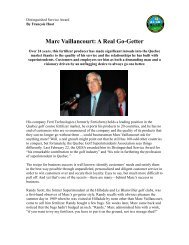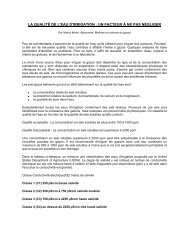Par/by François HuotPortrait d’entrepriseGazon Man<strong>de</strong>rleyCette gazonnière « vieille » <strong>de</strong> 50 ans compte sur ses atouts pour continuer <strong>de</strong> croître: récolte <strong>de</strong> nuit pour livrer frais lelen<strong>de</strong>main matin, pro<strong>du</strong>ction <strong>de</strong> plaques <strong>de</strong> très gran<strong>de</strong> taille mais <strong>de</strong> poids léger pour faciliter le transport et maximiserle ren<strong>de</strong>ment.Semences ou plaques? Chez Gazon Man<strong>de</strong>rley,la question ne se pose pas, même si chez elletout commence aussi par <strong>de</strong>s semences, que cesoit <strong>du</strong> bon vieux Pâturin <strong>du</strong> Kentucky à 100 %,<strong>du</strong> Pâturin <strong>du</strong> Kentucky cultivé dans un sol organique,une agrosti<strong>de</strong>... Gazon Man<strong>de</strong>rley sèmeaussi selon les <strong>de</strong>man<strong>de</strong>s particulières <strong>de</strong>s clientsqui souhaitent avoir un gazon concocté selon leurpropre recette. Dans ce cas, il faut compter undélai d’un an entre la signature <strong>du</strong> contrat et larécolte.L’entreprise Gazon Man<strong>de</strong>rley a été créée en1960 par John Hope. Mais pourquoi diable ce<strong>de</strong>rnier avait-il déjà choisi en 1945 d’appeler saferme Man<strong>de</strong>rley plutôt que Hope, son nom?Sans doute parce que lui ou un membre influent<strong>de</strong> sa famille avait lu le déjà célèbre roman Rebecca<strong>de</strong> l’auteure Daphné Du Maurier. Publié en1938, ce roman mis en film plus tard par AlfredHitchcock raconte l’histoire d’une jeune femmetravaillant pour la famille... Hopper. De Hope àHopper, il n’y avait qu’un petit pas à faire pourque John Hope choisisse <strong>de</strong> désigner sa ferme<strong>du</strong> même nom que celle où évolue l’héroïne <strong>du</strong>roman <strong>de</strong> la gran<strong>de</strong> auteure Daphné Du Maurierdont la réputation dépassait déjà les frontières <strong>du</strong>Royaume-Uni.John Hope espérait-il déjà pour son entrepriseune renommée internationale? On ne le sait pas,mais, sur son site Internet, Gazon Man<strong>de</strong>rleyrevendique une telle notoriété, indiquant que «personne ne pouvait s’imaginer que (son) nom atteindraitune renommée qui peut presque rivaliseravec celle <strong>de</strong> l’auteur ». Il est bien vrai que cetteentreprise qui confectionne un pro<strong>du</strong>it qu’onn’imagine pas exportable a réussi à se créer uneréputation qui dépasse les frontières.Comment y est-elle parvenue? En collaborant à laformation d’organisations qui offrent <strong>de</strong>s servicesà l’in<strong>du</strong>strie <strong>du</strong> gazon et en travaillant par exempleavec la Georgia Seed Development Commission(GSDC) et la Georgia Crop Improvement <strong>Association</strong>(GCIA) afin <strong>de</strong> créer l’International TurfgrassGenetic Assurance Program (ITGAP). C’est ce<strong>de</strong>rnier organisme qui a établi une norme internationalepour la pro<strong>du</strong>ction <strong>de</strong> gazon en plaques<strong>de</strong> qualité dans le mon<strong>de</strong>.Encore mieux, c’est Gazon Man<strong>de</strong>rley qui gèrele programme <strong>de</strong> certification internationale <strong>du</strong>gazon en plaques. À titre, l’entreprise basée à Ottawa« administre tous les aspects <strong>du</strong> programme<strong>de</strong> certification ITGAP. Ce programme fournit auxplanteurs <strong>de</strong>s ressources <strong>de</strong> marketing et <strong>de</strong> vente,y compris <strong>de</strong>s certificats, un placement sur lessites Web et <strong>du</strong> soutien en marketing. »Bref, Gazon Man<strong>de</strong>rley, c’est <strong>du</strong> sérieux. « Et,ajoute André Notz, son directeur national <strong>de</strong>sventes, une entreprise respectueuse <strong>de</strong> ses employés<strong>du</strong> Québec, une caractéristique qui setra<strong>du</strong>it par l’engagement <strong>de</strong> personnes bilinguesau siège social d’Ottawa. » Une attitu<strong>de</strong> digne <strong>de</strong>mention quand on sait que l’entreprise ne compteau Québec que <strong>de</strong>ux employés à temps plein!Évi<strong>de</strong>mment, ces <strong>de</strong>ux employés reçoivent <strong>du</strong>renfort l’été alors qu’une trentaine d’autres personness’ajoutent au <strong>du</strong>o <strong>de</strong> permanents.Plus gros pro<strong>du</strong>cteur <strong>de</strong> gazon en plaques au Canada,Gazon Man<strong>de</strong>rley cultive <strong>du</strong> gazon sur unesuperficie <strong>de</strong> quelque 7 000 acres, soit sur unesurface équivalant à celle d’environ 250 terrains<strong>de</strong> football américain. La pro<strong>du</strong>ction est réaliséesur cinq sites <strong>de</strong> pro<strong>du</strong>ction dans <strong>de</strong>s localitésontariennes proches <strong>du</strong> Québec et situées à 90minutes <strong>de</strong> route <strong>de</strong> Montréal. Même si les terrains<strong>de</strong> golf représentent un excellent débouché,ce n’est pas le seul et sa part varie d’année enannée, ce qui interdit, explique André Notz, «toute statistique précise sur la part <strong>de</strong> marché représentéepar le golf . Globalement et envisagésur plusieurs années, le marché <strong>du</strong> golf baisseprogressivement même si notre entreprise réussittout <strong>de</strong> même à tirer son épingle <strong>du</strong> jeu. » <strong>Le</strong>sautres clients <strong>de</strong> l’entreprise sont <strong>de</strong>s entreprises<strong>de</strong> paysagement et <strong>de</strong>s grands centres <strong>de</strong> distributioncomme Rona.L’un <strong>de</strong>s <strong>de</strong>rniers terrains « tourbés » au Québecpar Gazon Man<strong>de</strong>rley est le neuf trous <strong>du</strong> <strong>Golf</strong> Île<strong>de</strong>s Sœurs. Ce travail a été effectué rapi<strong>de</strong>mentau rythme d’environ 7 000 mètres carrés <strong>de</strong> surfacepar jour grâce à l’utilisation <strong>de</strong> grands rouleaux<strong>de</strong> gazon <strong>de</strong> 33 mètres carrés (360 piedscarrés) et a permis au club d’amorcer rapi<strong>de</strong>mentses activités, car il est généralement possible <strong>de</strong>commencer à utiliser un terrain tourbé environ 25jours après la pose. « Notre technologie permet<strong>de</strong> pro<strong>du</strong>ire <strong>de</strong>s rouleaux comportant peu <strong>de</strong>terre <strong>de</strong> sorte que l’on peut mettre sur une seulepalette <strong>de</strong>s rouleaux couvrant une surface <strong>de</strong> 75mètres carrés. »Est-il toujours avantageux <strong>de</strong> procé<strong>de</strong>r ainsi? AndréNotz vous répond: « Tout dépend <strong>de</strong> l’achalandageprévu : s’il est prévu qu’un terrain doitrapi<strong>de</strong>ment accueillir <strong>de</strong> nombreux joueurs, celarend avantageuse la pose <strong>de</strong> tourbe, même sielle est plus coûteuse que le processus <strong>de</strong>s semailles.La pose <strong>de</strong> plaques évite par ailleurs bien<strong>de</strong>s problèmes susceptibles d’être causés par<strong>de</strong>s pluies abondantes, le soleil, une pério<strong>de</strong> <strong>de</strong>sécheresse... »André Notz note par ailleurs que Gazon Man<strong>de</strong>rleyoffre <strong>du</strong> gazon à racines nues, un pro<strong>du</strong>itunique souvent utilisé pour les verts et qui offrel’avantage, comme le gazon semé, <strong>de</strong> ne présenteraucune stratification entre le gazon et le solqui le reçoit. Et c’est avec une fierté non camoufléequ’il indique que Gazon Man<strong>de</strong>rley cultiveson gazon sur un sol organique qui, parce qu’ilconserve bien l’humidité, ne nécessite aucun systèmed’irrigation autre que la... pluie!20 Printemps 2011
Portrait d’entrepriseMan<strong>de</strong>rley TurfgrassThis “venerable” 50-year-old sod farm is leveraging its strengths to continue growing, including nighttime harvests to<strong>de</strong>liver fresh pro<strong>du</strong>cts in the morning and pro<strong>du</strong>cing very large but light pieces of sod to facilitate transportation andmaximize efficiency.<strong>Golf</strong> île <strong>de</strong>s sœursTo seed or sod? At Man<strong>de</strong>rley Turfgrass, there’sno question, even though everything there toostarts with seed, whether it’s good old 100% Kentuckybluegrass, Kentucky bluegrass grown in organicsoil, bentgrass or something else. Man<strong>de</strong>rleyTurfgrass also sows grass to accommodatespecial requests from customers who want turfconcocted according to their own recipe. In thosecases, customers have to wait a year between themoment they sign the contract and the time thesod is harvested.Man<strong>de</strong>rley Turfgrass was foun<strong>de</strong>d in 1960 byJohn Hope. But what prompted him to namehis farm Man<strong>de</strong>rley rather than Hope, afterhimself, as far back as in 1945? No doubt becausehe or an influential member of his familyhad read the famous novel Rebecca byDaphne Du Maurier, whose reputation hadalready spread outsi<strong>de</strong> the United Kingdom’sbor<strong>de</strong>rs. Published in 1938, the novel (whichAlfred Hitchcock later ma<strong>de</strong> into a movie) tellsthe story of a young woman working for the“Hopper” family. “Hope” was just close enoughto “Hopper” to inspire John Hope to namehis farm after the one featured in Daphne DuMaurier’s novel.Was John Hope already hoping that his companywould achieve international recognition?We don’t know, but on its website, Man<strong>de</strong>rleyTurfgrass claims to have earned such wi<strong>de</strong>spreadvisibility, stating that “none guessed that their useof the name would one day rival the author’s.” It isin<strong>de</strong>ed true that the company—whose pro<strong>du</strong>ct isdifficult to export, or so one would imagine—hassuccee<strong>de</strong>d in gaining a reputation that exceedsour bor<strong>de</strong>rs.How did it accomplish all this? By playing an instrumentalrole in the formation of organizationsthat serve the turf in<strong>du</strong>stry and working si<strong>de</strong> bysi<strong>de</strong> with the Georgia Seed Development Commission(GSDC) and Georgia Crop Improvement<strong>Association</strong> (GCIA) to create the InternationalTurfgrass Genetic Assurance Program (ITGAP), aprogram that has set a new standard for qualityturfgrass-sod pro<strong>du</strong>ction worldwi<strong>de</strong>.What’s more, the Ottawa-based company managesall aspects of the international turfgrass geneticassurance program, which provi<strong>de</strong>s growerswith marketing and sales resources, includingcertification, website placement and marketingsupport.In a nutshell, Man<strong>de</strong>rley Turfgrass is a seriouscompany. “And one that respects its Quebecemployees,” adds National Sales Director AndréNotz, “which is why it hires bilingual people for itsOttawa head office.” It’s an attitu<strong>de</strong> that’s worthyof note, consi<strong>de</strong>ring that the company has onlytwo full-time employees in Quebec! Obviously,those two employees receive reinforcements<strong>du</strong>ring the summer, when some 30 additional recruitsstep in to lend them a helping hand.The largest sod pro<strong>du</strong>cer in Canada, Man<strong>de</strong>rleyTurfgrass grows turf on approximately 7,000acres of land, the equivalent of 250 football fields.Pro<strong>du</strong>ction takes place at five Ontario sites locatednear Quebec and within a 90-minute drive ofMontreal. Even though golf courses are an excellentmarket for the company’s pro<strong>du</strong>cts, theyaren’t the only one, and their share of Man<strong>de</strong>rley’stotal sales varies from year to year. As a result,explains André Notz, the company has no “accuratestatistics on golf’s market share. Overall,and over time, the golf market is in gra<strong>du</strong>al <strong>de</strong>cline,even though the company is still managingto do all right.” The business’s other customersare landscaping companies and large distributioncentres like Rona.One of Quebec’s last courses to be sod<strong>de</strong>d byMan<strong>de</strong>rley Turfgrass is the nine-hole <strong>Golf</strong> Île <strong>de</strong>sSœurs. The work procee<strong>de</strong>d quickly at approximately7,000 m 2 a day, thanks to the use of large33-m 2 (360-sq.-ft.) rolls of sod. That enabled theclub to begin operating quickly, since it’s usuallypossible to start using a sod<strong>de</strong>d course about 25days after the sod is laid. “Our technology allowsus to pro<strong>du</strong>ce rolls with very little soil, so we canput rolls with a total coverage of 75 m 2 on a singlepallet.”Beaconsfield <strong>Golf</strong> ClubIs it always cost-effective to use this approach?André Notz answers: “It all <strong>de</strong>pends on the anticipatedlevel of traffic. If the golf course is expectedto attract numerous players in a short time, it makessense to lay sod, even if it’s more expensivethan sowing grass. Laying sod also avoids manyproblems that could be caused by excessive rain,sun or a dry spell.”André Notz also notes that Man<strong>de</strong>rley Turfgrasssupplies soil-free turfgrass, a unique pro<strong>du</strong>ctoften used for greens that has the benefit, likesown grass, of not intro<strong>du</strong>cing any stratificationbetween the turf and the soil on which it is installed.And with undisguised pri<strong>de</strong>, he tells us thatMan<strong>de</strong>rley Turfgrass grows its grass on organicsoil which conserves moisture well and thereforerequires no irrigation system other than … goodold rain!Printemps 2011 21


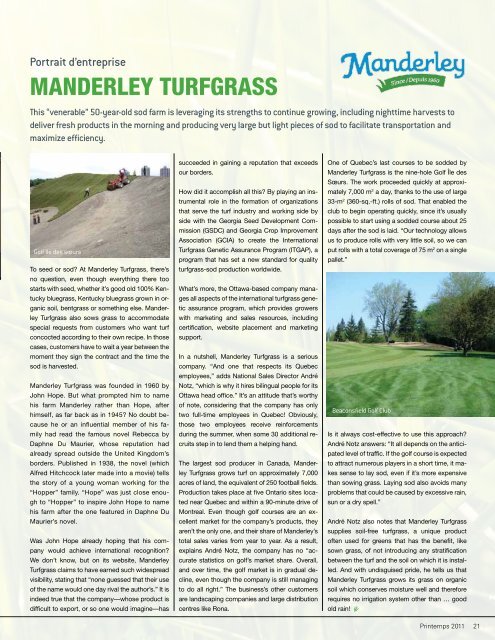

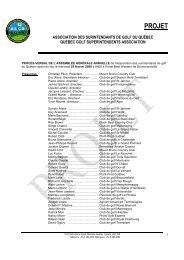
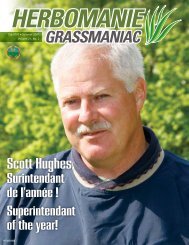
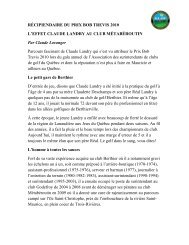
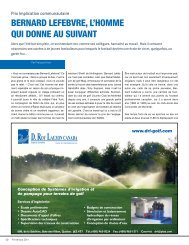
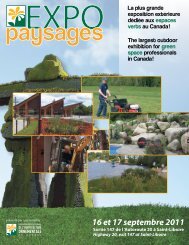



![Prix Bob Trevis - Daniel Read [Mode de compatibilité]](https://img.yumpu.com/38379520/1/190x135/prix-bob-trevis-daniel-read-mode-de-compatibilitac.jpg?quality=85)

